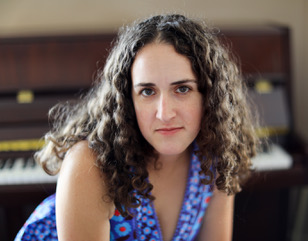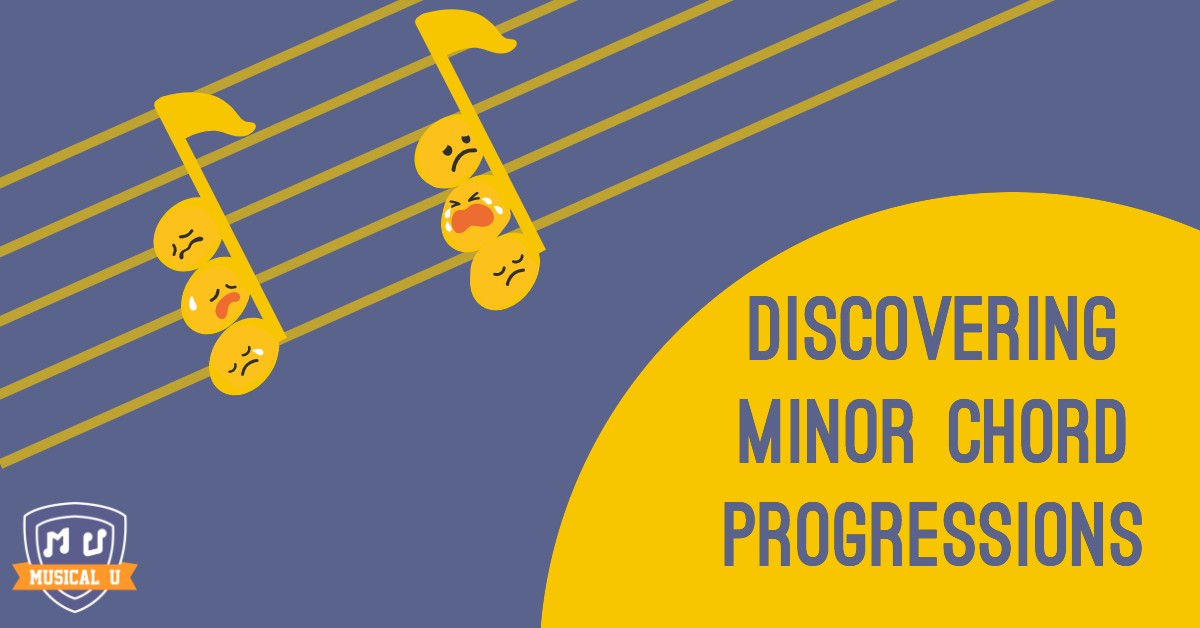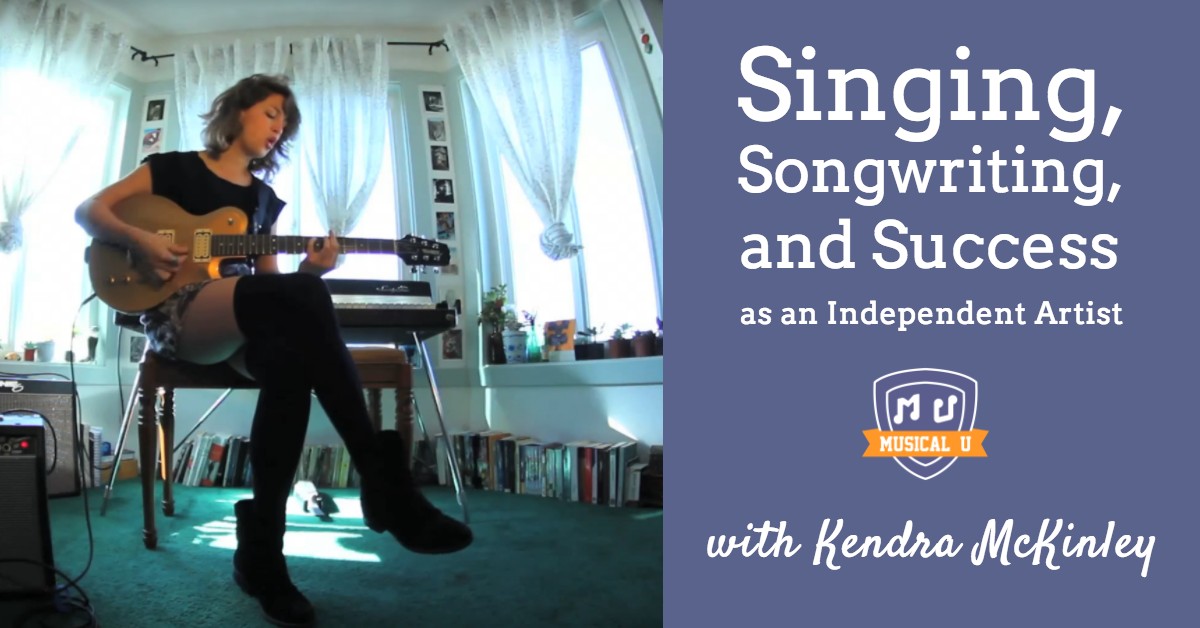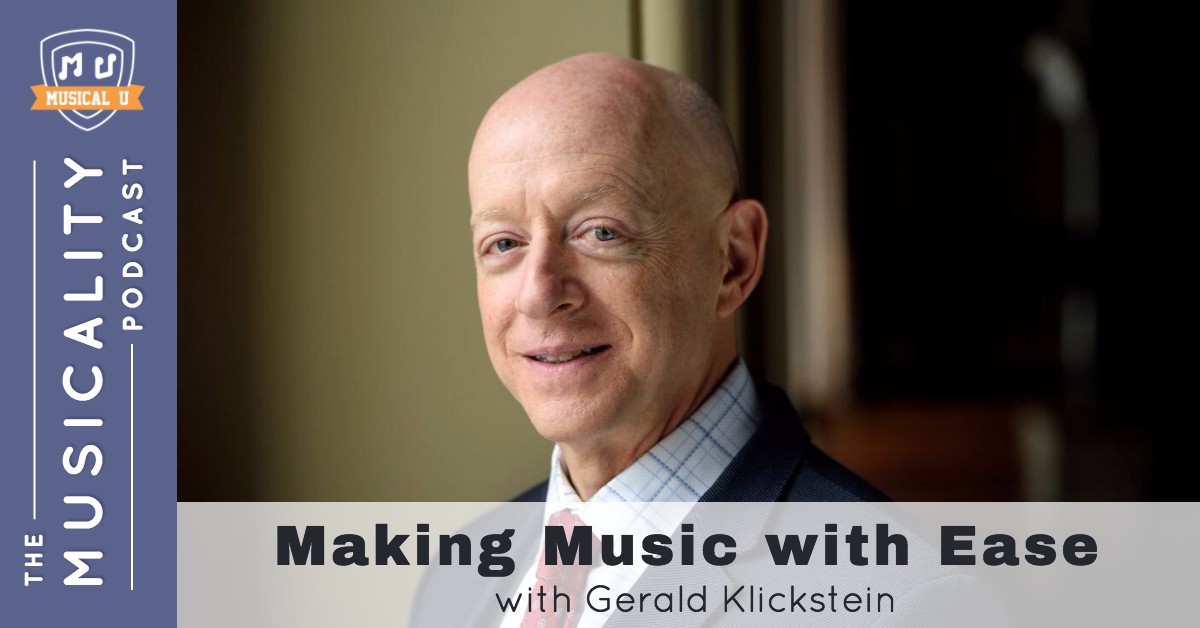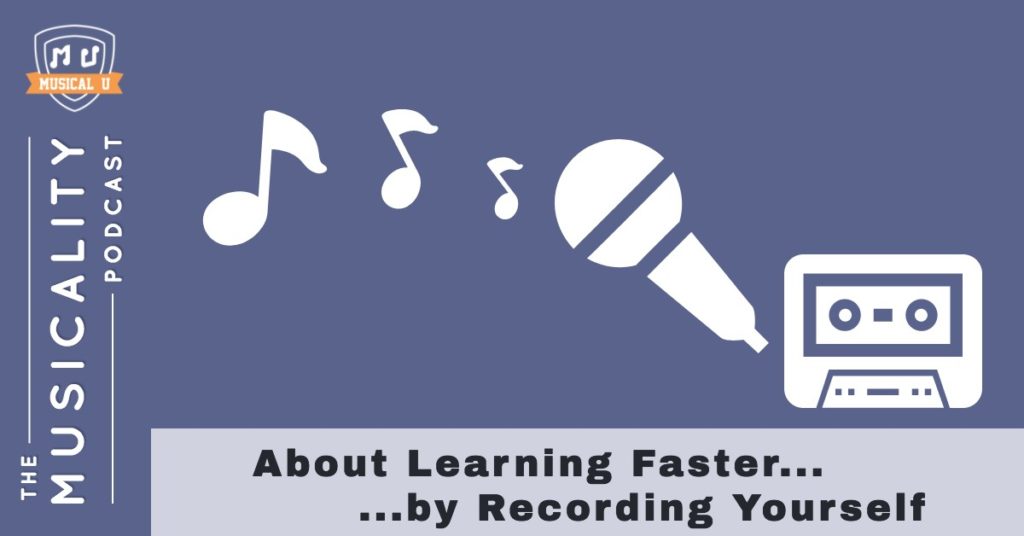Have you ever worried that you’re “tone deaf” or can’t sing? Or do you have a friend or family member who just can’t seem to sing in tune or in key? In today’s podcast episode we’re joined by a true expert who’s had some phenomenal results helping those who “can’t sing” to start singing in tune.
George was someone we reached out to when doing research a few years back for our Tone Deaf Test and SingTrue projects at Musical U.
Throughout his teacher career, George repeatedly found himself faced with students who just couldn’t seem to hold a tune and were reluctant to get involved in choir. He started “experimenting” with how to help them, and now with his “Music at Monkton” blog he regularly shares insights, techniques and triumphs as he goes about his work teaching music and leading choirs at a secondary school in the United Kingdom.
In this episode George shares:
- The most important lessons he learned from entering music contests as a child
- What can sometimes be missing from choirs – and the power of putting it in place
- How he helped just a couple – and then a whole horde – of shy teenagers to “calibrate” their voices and go from thinking they’re tone deaf to singing capably and confidently in front of people.
- The specific three-part approach George uses to create this transformation.
If you’ve ever wondered if you’re tone deaf or thought you just “can’t sing” – or if you’re a teacher who has faced people who feel that way and wanted to help them – this episode is one not to be missed!
Listen to the episode:
Links and Resources
Enjoying The Musicality Podcast? Please support the show by rating and reviewing it!
Rate and Review!
Transcript
Welcome to the show, George. Thank you for joining us today.
George: Thanks very much.
Christopher: So I’d love to start out at the beginning. Maybe you could share a bit about your early experiences learning music. How did you get started?
George: Well I started learning the piano when I was five. I’ve got a twin sister, so we had piano lessons together with the same little old lady who lives down the road. And very supportive parents and I think that was critical to our really early experience. My parents used to sit and listen to us practice. Not necessarily interfere and tell us what to do, just they just showed an interest in what we were doing which was really encouraging for us.
Christopher: Mm. And were you taking weekly lessons at that point?
George: Yes, weekly lessons and a really good old-fashioned lady, Mrs. May who taught me the piano and she was quite adamant that we had to do … I think it was, it was half an hour’s practice, and I think it was probably a day. I can’t quite get my head around that for a five year old but my mum was quite surprised that she said, “I’m not going to teach your children if they don’t practice for this amount every day.” So it was fun, it was engaging for me as a child. I found the whole thing captivating straight away. So I don’t think I found practice challenging but to have that kind of rigor behind it rather than just play with it and toy with it, I think was probably a really good start in life, musically.
Christopher: Yes, it’s wonderful to hear that you were both able to spend that much time and also keep it enjoyable and not really see it as a chore, but rather enjoy the practice of music making.
George: Oh absolutely, and I remember my first piano book and there were black and white pictures and if we had done really well we could color them in. But there wasn’t, it wasn’t in the fun in the days, today where everything is color and interactive. It was proper. But I just loved just seeing the book and turning the next page and seeing what I was going to learn next. I enjoyed the challenges that it presented. And I think I was probably very keen to get home and get going straight away.
Christopher: That’s great to hear. And did you find it came easily to you? Were you someone who kind of felt that music was natural for you from the beginning?
George: That’s what I remember. I think we can reinvent our memories a little bit. Jumping ahead, I very recently found my old Grade Five mark sheet from my Grade Five piano exam. Thinking myself to have always been an amazing sight reader, I actually failed my sight reading for Grade Five piano. Which came as something of a disappointment to me. But my recollection is that yes, I found it straightforward, quite straightforward, but always looking for the next challenge so I think I was always challenging myself as well as being challenged. So never easy because I was always looking for it to be challenging, I think.
Christopher: And were you performing at that time or were you just practicing at home for your own enjoyment?
George: On the piano I did a lot of performing. We used to enter music festivals. Just local competitive music festivals at weekends. My teacher had a fine reputation and her pupils would walk away from these things with trophies. That was me and my sister as well.
We did a lot of playing in that way and I actually think watching lots of people perform as a youngster was very instructive in hindsight. To see already, from a young age, watching people, watching what was good, what I liked, what was a good performance, what was a performance which made you not want to be in the room because it was so … sort of unpleasant for everybody ’cause they were so nervous it made you nervous in the audience. All of those things. Hearing other people play too fast and not being tidy enough, myself included.
Christopher: I believe you are a singer as well, is that right?
George: Um, I wouldn’t call myself a trained singer but I sing, I can sing just about anything but I did train, I was a church chorister from the age of eight to 13. That was a parish church in Warwick in the UK, and we used to sing two Sunday services so for that we had two weekday rehearsals as well. And that was a full service music for those Sunday services, so we learned a lot of music each week. And it was my life for five years, I absolutely adored it.
Christopher: Terrific. And what was that experience like to learn so much music each week? How did you cope with that?
George: Well I still now say the opportunity to be a chorister, somebody like that is the best education that a child can have. It certainly was in my case. I think we had 30 boys in the choir which was a big choir, and much of it is just by osmosis. Being a big team and an eight year old looking at the thirteen year old singing, and the head chorister at the time, he was my hero. And I watched him and saw him sing and saw him open the music and just get on with the job, and thought well that must be what you’re supposed to do. And I think that’s the way most of us learned.
We were also assigned to a senior chorister so each junior boy was constantly next to a senior boy and one of the things that they did was follow the music with their finger. Which sounds really basic, but I’ve since watched older students in choirs and they have no idea where they are in the music, especially if it’s in more than one stave. But it was just followed through all the time and once the younger chorister got more competent the senior chorister would insist that they followed with their finger.
So just a tiny little thing, but lots of those little things really made a difference. And the other thing was we had whole scheme of tests, very simple, but not such simple hoops to jump through. And little drawing pins in a board to show our progress. So they started out simple things, note names, so our assistant choir master would draw a stave, draw some notes on it, point to the notes and say, “What’s that note?” And one you were fluent in that you would get a little pin in the board. And that for me was amazing because that’s the kinda thing I love, is when someone’s gonna put a pin in a board. So I went straightaway and said yep, I can learn to do this.
So you could see your progress visually across the board. And there were about 30 tests. It was competitive. So I suppose it was probably like the boy scouts getting badges, but you weren’t getting a badge there-
Christopher: Gotcha, it’s great that you had a choir master who had thought it through so much.
George: That was something which was devised by the Royal Schools of Church Music, it was quite a big scale thing. But we had two choir masters. One was the scary boss and the assistant choir master was the guy who, I suppose rolled his sleeves up, and really got stuck into teaching the younger boys. And that’s the one now I really look up to, as someone who really shaped my musical life from there on in, I think. Mr. Baker his name was.
Christopher: Fantastic and those sound like really great stepping stones towards being able to sight sing, to be able to just look at the sheet music for a new piece and know in your head how it should sound. Was that something that came easily to you?
George: I think it probably did. I’d been learning the piano for probably two or three years, which was a good head start having learned at that stage. So the notation wasn’t new to me. But things like, we did sight read no jumps, it’s same stave drawn on the back of a piece of draft paper and Mr. Baker would point at a note and would sing and give us the first note. And then point to next note up or down the scale and we just had to sing and go up or down as he pointed.
And then the much more advanced test was called sight read jumps, where you would leave a note out. So it was just someone going through the basics of how the notation, certainly pitch, actually works. And then of course you’re just watching the notes, every rehearsal, they’re flying past on the page. So you’re immersed in it all the time. I think one of the issues with notation now is that people can look at it and think that’s scary. But it’s just like reading text, for me, the more you read the more familiar you get with it. It’s just a skill.
Christopher: That’s great and it sounds like it was a scale-based approach so analogous to the Sol-fa system or scale degree numbering that let you really understand how the notes were fitting in to the key.
George: Yes, I think so. I can’t remember whether I used to pitch, I didn’t use Sol-fa, I didn’t discover that until much, much later. We used to, I used to learn intervals from tunes. So a perfect fourth was Away in a Manger. (singing) It’s just completely out of context in some other piece.
Christopher: Right.
George: And we had to do that oral tests, the pianos exams and things as well. But I guess I spent time learning it because it was important to me.
Christopher: It’s fascinating. I wish I had had your choir master or your deputy choir master in my own musical learning. I was a chapel chorister myself in my school days and I have to confess, I got through the whole decade or so of singing in the church choir without learning to sight sing. I did it entirely by ear. I would kind of listen to how the melody was meant the sound and then I’d remember it and that would be fine. But for that first run-through I was almost useless.
I had come across intervals in my instrument learning, like you say it comes up in the oral tests for the exams. But I had no real connection between that and the notes on a page or how I was meant to use that to interpret the sight singing. And so I really wish I had had that kind of methodical introduction to how you can make sense of the notes on the page using the scale, and practicing in a more step-by-step way. I think that sounds fantastic.
George: I think the essence of it is in skilling up your team. I actually met my choir master last week, who I haven’t seen for about 33 years believe it or not. And we were talking about this and you have to have your team, however young they are, skilled up to do the job. I know many, many children I’ve taught who avoid learning to sight-sing. And it’s almost the task is to avoid anyone picking up on the fact that you can’t do it.
Which I think is a real shame and just needs to be tackled head-on. And anyone who comes to me and says, “I want to learn to sight sing,” I will tie them down until the job is done. I won’t let them retract that. But so many children especially can avoid that. And then they have all sorts of aggression tactics, if that’s the wrong phrase, to disguise the fact that they can’t do it to make it look like they can.
Christopher: Absolutely. I was very much kind of, I’d almost say a backing singer. I was a treble and then a bass and I was contributing to those sections but I wasn’t gonna be the one pitching the first note, and I wasn’t gonna be the one bravely stepping forwards to volunteer for the solo because I just did not have that skill in my repertoire.
George: We did have a system, it’s quite common, where if you sang a wrong not you just put your hand up briefly so show that you’d make a mistake and that you knew you’d made a mistake. Which is something I employ sometimes in rehearsals. In a rehearsal I say to people always just make mistakes. In fact if you make a mistake and you sing it loud if that person’s next to you give them a pat on the back and say, “Well done for getting it wrong in style.” ‘Cause that’s the way you learn is by getting it wrong. And then you know it’s not that one for next time.
Christopher: I love that and I think it’s such an unusual attitude to hear from that traditional church music background. I wish that was used more, well throughout music, but particularly in that more traditional, perfectionist, formal setting. I think we could all do a lot better if we were willing to make more mistakes.
George: Mistakes are the way to, they’re the way forward. Absolutely they are. And if you’re always a backing singer, you’re never … I quite often think if the floorboards, if you’re walking somewhere and the floorboards are rotten the only way you’re gonna know where the floorboard is rotten is if you actually put your foot on it, and put your weight on it. If you just sort of tap it with your foot it’s not gonna give way, you don’t know. It’s the same with notes, or anything. If you jump on it, full weight, and it gives way you’ll know it’s not the right one.
Christopher: Right, and you can repair it for next time.
George: But if you never really commit you just never know.
Christopher: Mm. And so you went on then to become a teacher yourself and specifically a piano teacher I believe.
George: Yes.
Christopher: How was that experience for you?
George: Amazing. I trained at the Royal College of Music, I was an organist or pianist and I had a sensational piano teacher. A Chinese man, Yu Chun Yee And I went to him one day and I said, “I’ve bought this book. I’ve just been asked to teach piano to a six year old and I’ve never done this before, what should I do?” And this man who had taught some of the great concert pianists and has played solo at the Proms, you name it … Turned into a sort of another five year old, really. I’d never seen him teach like that but he gave me a demonstration of how I might approach a lesson. And it was extraordinary.
But I started teaching, someone asked me if I would teach their five year old piano, five or six I think they were. And I said well I’ll give it a go, I’ve never done it before. And my first attempt I actually had the book and it had middle C, which is often where you start on the piano, just middle C with each thumb and trying to get the rhythm right. And this child couldn’t play all the right notes in the right order with the right rhythm. And I found that very frustrating. And I went away from the first lesson thinking, “He couldn’t get it right, it wasn’t perfect.”
And then thought “well hang on, he’s a five year old. That must have been really boring, trying to do that.” ‘Cause he kept asking me, “What do these pedals do?” and “How many notes are there?” and “What happens if you play them all at once?” And it made me begin to think well maybe, maybe there’s another way of doing this other than just instructing the child to get all the notes in the right order with the right rhythm, which is what I want.
So I just began going on, and I had hoards of pupils. Within a few months I had 30 something pupils I think, over the course of that year. Some went to school but then every day when school ended they were queuing up outside my door, half an hour at a time. And we just played games. And any flight or fancy that they would go on I would follow, always in my mind thinking how on earth are we gonna bring that back to, “Can you play from C to D?” But you make C to D like walking, or a jumping exercise or something and you turn it into something creative rather than note reading. Because note reading in itself is not very exciting. And I think I’ve always-
Christopher: And was that easy for you to do? Once you had that insight that you could make it fun and game-like …
George: Well I used to worry I was taking money off people for the wrong reason. On Saturday morning I used to go around the local, where I live from place to place with families I knew with young children, and hype up their child for half an hour. And then leave and onto the next one. And I had to justify teaching them but it was fun, they spent it in front of a piano. We did learn stuff, not all of it was necessarily the piece on the page.
But actually I don’t think it’s important at that stage necessarily for that to be the case. We would sing, we would make a lot of noise, we would … play a bit of piano, we would read, we’d play games, all sort of things. But they loved it. And I think they learned to associate music with being engaging and fun, and what’s gonna happen next. And I think it was always my intention to surprise and to keep them engaged by surprising them.
I think that’s a wonderful way of teaching and it’s the way I’ve taught ever since. I really don’t like just telling people and expecting them to know. Telling is not teaching, I think someone told me recently. I think that’s very important.
Christopher: It sounds like you really stepped away from that traditional music teacher model of aiming for perfection, and note by note perfect rendition, and passing the exams with perfect marks, and focused much more on what you felt the spirit of music making should be
George: Yes. I think there’s a balance between … I know what perfection is, I’ve done a lot of it. Not myself, but I’ve been in that environment. I know what high standards are. But as I get older I … And the people I teach now, they’re not going to be the next concert artists, they’re not going to make their millions. They’re just people who are going to enjoy music for the rest of their life.
And so I’ve set myself to thinking yes, for the ones who I, I always stretch my pupils, everything. I think we should constantly be striving to be as good as we can be. But perfection is not one of the things on the list of which you’re necessarily aiming for. You’re aiming for a skillset whereby someone can enjoy and be skilled up so they can stand on their own two feet and continue to make progress by themselves. I think that’s more important than perfection.
Christopher: And I love that about your kind of philosophy to music teaching. It really comes across in the Music@Monkton blog that you are not a wishy-washy teacher who just wants everyone to have fun and go home with happy memories. [crosstalk 00:22:59] You are someone who manages to combine….
George: Oh, I can’t stand “fun”. Sorry to interrupt. If someone says I just want my child’s lessons to be fun that really irritates me because I think it’s the wrong fun, it can be the wrong word, “fun”. I think what they suggest to say … I don’t know, they don’t want to be stretched. They don’t want to make progress? I don’t know what fun is but I think it often can be a fleeting thing, and I’d much rather they were fulfilled. Some sense of permanence, some sense of change, something that’s developed rather than just they’ve had fun and then they stop and nothing is any different.
Christopher: Absolutely. I think when you focus only on fun it can be very frivolous and in the end not go anywhere. Whereas I think with your writing and the way you teach, you find a balance between enjoying learning music and actually putting in place some very serious skills and a mindset of confidence and independence.
George: Oh, yes. And once someone’s got the bit between their teeth that in itself is fun, that’s the enjoyable bit is the … “This is challenging but I’ve got some ways that I can engage with it.” I think that’s the real crux of it. If you feel that you’re gonna fail, most people will say, “Well, what’s the point in doing this?” But if you have ways through where you can say, “Yes, by doing this and this and this I can achieve,” that in itself is so … That’s the fuel in the pupil. Once you’ve ignited that there can be no stopping them. And then it can be as challenging as you like and it’s still fun.
Christopher: Mm-hmm (affirmative). So something you specialize in and I really admire and respect and have learned a lot from you about is helping in particular those who feel untalented or that they are not musical and fear that they can’t sing. And I think this was what originally connected us, was your project The Choir Who Can’t Sing. I’d love to have you share a bit with the audience about that project, where it came from, and how you approach things there.
George: Yeah, well at Monkton where I teach, which is just outside Bath in the UK, it’s a private school and we’ve got about 400 senior school pupils so 13 to 18. We sing in chapel, we sing hymns, and we have a singing practice every fortnight which is me and 400 kids. Which can be quite hard work on a Thursday morning. And one cold November morning not long after I’d arrived, the singing was particularly dismal.
And I’d been working with a couple of sixth formers, something I called the “Tone Deaf Project”. Where I had a couple of pupils, so they were 16, 17. One girl, one boy. Both said they thought they were tone deaf. And I worked with the pair of them and it was evident that they weren’t. In Alex’s case, the girl, it was just a confidence issue. Over the course of a few weeks, just 10, 15 minutes a week, she was transformed really from a girl who was … Never looked you in the face, hair over the eyes, just constantly looking over her shoulder, she was just transformed in confidence through learning to sing. And in fact that’s why she wanted to learn to sing ’cause she said, “If I can sing I can do anything.”
So I’ve done a bit of spade work and this November morning I said to this girl, “Look, anyone can sing. We can do better than this. I’m gonna start a choir for boys and I’m going to teach them to sing as a choir. And we’re gonna report back to the school in six months and prove anyone who wants to be a part of it that they can do this. So I need volunteers.” And surprising I was inundated with people coming up to me and saying, “Yeah, I’ll have a go.”
And that was the birth of the Choir Who Can’t Sing, so that was I think November 2011. And six months later I reported back to the school and we sang Shine by Take That to the whole school and it was amazing. So it was really just a … The intention was for it to be a statement of, “This can be done.” But it’s been going ever since and what it now stands for is everyone in the school knows if you can’t sing, if they come and see me I’ll prove to them otherwise. And the Choir Who Can’t Sing still exists and it stands there as a very, very strong signal, I think, which says, “You’re wrong, you can sing.”
Christopher: Absolutely and to the point even of YouTube videos of your choice, where I think anyone listening, anyone who goes and watches those videos, and we’ll definitely put some links in the show notes, can see very clearly these teenage boys who were sure they were tone deaf and couldn’t sing are up on stage giving a terrific rendition of a pop song. And I think that should be inspiring to anyone, any listeners who maybe have doubts about their own ability. This is definitely proof that you may be drastically underestimating what you’re capable of in music.
George: Indeed. We’ve got one, which we’ve done twice actually, it’s called You Raise Me Up which is I’m sure a song that everybody listening knows. And our first performance was a flashmob in the school dining hall during evening supper time. And backing track just started up and I’ve got the boys arranged, with their trays, across a dining hall and one at a time they stood up and started singing.
And it’s amazing, it’s not great sound on the YouTube clip we’ve got of it, but what is amazing is they’re standing in front of their mates a couple of feet away from them and they’ve got the confidence to be themselves and sing. Which is quite remarkable I think. One of the things which singing, I think it’s the most personal thing we do. I think it’s more personal than anything else, you can take the clothes off someone’s back but you can’t make them sing. And it’s something you have to want to share. It comes from the most intimate parts of us. So to actually stand in front of anyone and sing, and if you ask most people in the street you just went up to them and said, “Would you sing to me?” Most of them will retreat into themselves very quickly.
Perhaps as a team what we’ve done is build the confidence in themselves, and that’s the thing that really fires me as a teacher, is discovering self-confidence in young people. Not just their musical skills. But if you’ve got the confidence to sing to someone you can do anything.
And on the other video we made, which was a much more highly produced one, we filmed it much more carefully and it’s got the whole lot of the boys singing at the end but it features eight soloists in the first couple of verses. And each of those lads in particular has got their own story. So yes, in the Monkton context they’re known as friends of other people. If you watch the video, if you look at say the seventh lad on the video comes along he’s know at “The Opera Singer” to his mates ’cause he’s got an amazing voice. But when I discovered him in Year 13, not Year 13, age 13, he couldn’t sing a note. So if I sent him a note he would sing too low, and then if I send him a low note he would sing too high. He couldn’t pitch at all. He joined the choir I think probably aged about 16, and if you listen on the video he has a beautiful voice and he can sing in tune.
The third lad on there was in the choir for five years and sounds like a pop star, I mean he’s amazing. And there’s the second one was told by his own mother that he was tone deaf like she was. At a young age, so he never sang. And he joined us in the Sixth Form, aged 16, playing in the first 15. And I collared him one day and said he could should come along to choir and he couldn’t sing a note if I sang it to him. And I told him to come and see me and we would calibrate him, is the term I use with some humor, just to show him where his voice lies. And he sang me over the course of a few minutes, sung me back a few notes, all of them beautifully in tune and I said to him, “You’re fine. There’s nothing wrong. You work just fine.”
And he broke down in tears, which was very moving. And I think it was a very big moment for him. And I think a lot of people are like that, they’ve been told by someone they can’t sing and so they don’t sing, and then they don’t get the practice which everyone else has had for the last however many years. So they fall behind even worse and it just builds up to the point where they just … They won’t sing from there on in unless someone intervenes.
So yes, those videos are full of, well my life for the last five, six years is full of teenage boys who have swaggered in and said, “Yeah, right. You won’t get me singing.” And in time they do and I see them change. So it’s, I enjoy what I do.
Christopher: I think that’s just, it’s just phenomenal. I think you and I first bonded over our shared anger at people being told early on that they’re tone deaf or can’t sing and that kind of locking them out of the world of music for, in some cases, the rest of their life. And I just have so much respect and admiration for the work you’ve been doing in this way.
I know that our listeners are desperate for me to ask, what did you do if we take those two first students you were helping who just spent 10 or 15 minutes a week for a few weeks, or we take one of these boys from the videos who you were calibrating, can you give us any kind of glimpse of what you were doing with them that helped them kind of find their way to singing in tune?
George: These first two, Alex and Andy, I was finding my way because I’ve been singing, myself, as a chorister from a young age. I’ve been doing this for a long time and I think one of the things in teaching, again, through making mistakes is … The way I teach is by working it out for myself. And I think super talented people, if you can already do it, you don’t necessarily stop and think, “Well how does this work?” So I think most of us when we sing, because we can sing already we just take it for granted and that’s it, end of.
But I started scratching my head and thinking well actually what are the mechanics here which are getting the way? What’s making this difficult? And approached both of these two saying, “Here I am, I want you to imagine I’m wearing my white lab coat as a scientist. This is not about you, this is just about the results we get. And I’m going to run a few tests and observe what I see. So you’re not getting it right or wrong, it’s just intriguing. And if I ask you to do this and I change something, what’s different? So we’re gonna approach this together as an experiment. And I don’t really know the answers either, so we’re both in this together.” Which I think was a stroke of … I wouldn’t call it, yes, it was a stroke of genius on my part. In as much as it took the pressure off these guys to feel already vulnerable that they couldn’t sing, the last thing that I wanted to do was say, “Sing this. Oh no you can’t sing that, you’re rubbish.” So to approach it in that way I think really took the pressure off.
And there are three things I discovered. One, that people don’t listen carefully enough. So you actually need to take aim when you sing, and in order to take aim you need to hear what it is you’re going to sing. So the first thing I do is I just sing a note and say, “Can you imagine yourself singing that note?” It needs to be a note where it’s in their range, obviously. I would never play a note on the piano because there’s no biology to the piano. So you sing a note which is gonna be comfortable and then say, “Now listen to that. Now I’m gonna sing it and I want you to pretend that it’s your voice that you hear,” and go through the motions of it. And that just somehow makes them listen more carefully to the pitch. And we do that twice and then I say, “Okay, now you turn your volume up and you’re gonna sing it.” And I’m not kidding, nine times out of ten, more than that, they sing back the note that I’ve just sung. Simple as that.
No one has ever engaged them in a task where they’re listening critically. So I think they just open their mouth and a note comes out and they’re disappointed it’s not the right pitch normally. And then you sing a note higher and they’re listening critically so you go through the same process. “Sing the note, don’t you sing it, just listen to me, imagine singing this. You might need a bit more energy. Are you ready? Go for it. Sing the note.” Out it comes. And once you’ve got a couple of notes in place you’ve won them because they think, “Okay, I’ve never been able to do this before. Someone is saying I’m doing this right.” And they can hear that it’s right. And it’s just having switched on a critical ear.
The second thing is good support, breath support. I’m not a trained singing teacher but I know enough about it to … You need that to work well otherwise they can’t sing, certainly higher notes. And for lads especially they just don’t know where the upper octave is, they’ve never been up there. They talk in a very low and uninspired voice, teenagers are famous for it. So I tend to get them to sing somewhere in what I call their lazy voice. If they go, “Oh, yeah. Oh, yeah, do that.” And so you sing this note, (singing) because you know they’re gonna be able to reach it. But if you ask them to go (singing) they’ve just not idea where that is. Because teenagers don’t use that expressive part of their voice really. So that’s a few lessons down the line.
And the third part is confidence, and just the belief they can do it. And an energy to go for it, which is kind of linked with the confidence. When I had done my first session with Alex I got her singing notes in a scale really quickly. And I tried to get her to sing a whole octave and we got to the top note and the last couple just went a bit flat to the top of the scale. So I said, “We’re gonna need a bit more energy to get there, I think. Why don’t you throw your arms out when you get to the top?” And what I discovered is she couldn’t throw her arms out because she couldn’t even hold her arms out there anyway because she was so unconfident, she just wasn’t able to stand with her arms open wide. Which said a lot and that was a good lesson for me as well.
So it’s those things, really. It’s critical listening, which I think … As I say, nine times out of ten, more, people who can’t sing just haven’t worked out that they need to take aim. Which is, that’s what’s going on inside your head and that comes right back to all these other skills we’ve talked about: sight signing, the musician in us is in our head, not really in our voice. If you can’t hear it in your head, which sadly quite a lot of musicians-in-inverted-commas can’t, I fear. They just read the notes and then they just come out. It’s all what’s going on in your head that’s important.
So it’s that critical listening, it’s support of the breath, and confidence and energy. And that is enough, in my experience to get the vast, vast majority singing, possibly in tune.
And from then on in you just need a lot of practice. You need to be in a choir and you need to sing with other people who sound the same as you. And that’s where The Choir Who Can’t Sing comes in.
So what we did early days is we rehearsed weekly but in the gaps were constant knocks on my door. “Sir, can I just have five minutes of your time? I don’t think I did very well last week.” So I was just teachings lots and lots of five minute, ten minute singing lessons. But it’s actually as much as singing lessons it was confidence boosting and nurturing.
But now the choir is back to where I was as a chorister I think, which is you come along, you see other people who’ve been in the choir a little bit longer, and you watch what they do and you copy. And before long you find that you’re at the point where the more experience ones were when you joined, and they can’t see how they got there.
So if a new lad comes along to the choir and some might have a laugh if they can’t sing a note in tune because they knew they were there, not so long ago themselves. But it doesn’t take them long to catch up.
Christopher: And would you still always be doing a bit of one-on-one work with them? Or can they at this point join the choir and kind of learn by osmosis in that way?
George: Oh, they can join the choir, absolutely. But I’ve never forced anyone to come to choir. It’s the way I work, it’s an open … The stage is set for them, if you like, and if at any point you want to come along you’re welcome. And quite often I get, “Yeah, right. As if I’d go to choir.” But it’s not uncommon for a 16, 17 year old lad to come to me who’s been in the school for three years, so he was in my class, aged 13, haven’t seen much of him for two years. And he will come up and say, “Sir, can’t quite believe I’m saying this but can I join your choir?” And the first couple of times it happened I more or less told them to get lost, stop taking the piss.
Actually once they realize they want to do it, that’s where you’ve really got people. And that’s why I love teaching adults as well because they know what they want. We have to, I suppose, force children to go to Maths and English and all those core subjects, but yes, music should be a core subject. But once someone’s decided they want to do it that’s the best audience in many respects because then they’re helping themselves along the way rather than being dragged along. And there are quite a lot of choirs of people who don’t necessarily want to be in them, in my experience.
Christopher: I am so happy that you came on the show today to share this because I think around the world even today children are having the experience I saw so many have in my schooldays, which was first day of term everyone has to go up stand beside the piano, choir director plays a note on the piano, and if they can’t sing it they’re not in the choir. And they probably spent the next 30 years of their life thinking they can’t sing. And I love how simple you’ve made it, how simple and effective you’ve found it can be to just spend a little bit of time calibrating them, as you put it, and showing them that there is a simple process to singing the right note. And if you take a moment and you’re singing a song note rather than a piano note, it can be very quick to dial in your calibration and start to sing in tune.
George: Yes, it really is. But this … I don’t know what’s going wrong and I don’t know whether we’re singing less together in communities but my feel is that a lot of young people aren’t learning to sing when they’re little. Maybe their parents don’t sing to them, maybe their parents were in a generation now where they weren’t sung to. So I think the basic mechanics of it is perhaps not as … a part of our culture we grow up in now. So it does need intervention. Or it needs someone to shout very loud from a very public place, “Everybody get somewhere where someone will teach them to sing and we can fix this very quickly.”
Christopher: I love that.
George: I teach in a school, it’s a private school, yes they’re privileged kids in some respect but ultimately for me if someone can’t sing they’re missing something that’s so intimate. And if they have children then won’t be able to sing to their children at three o’clock in the morning. And those kind of things that we use singing for. I just love hearing people sing badly to their little children because it’s great because of the intimacy of it. It doesn’t matter if they’re not very good at singing. It’s much more important to have that vital intimacy as part of our lives I think.
So again, we’re far too critical of each other. And it comes back to that perfection again. And yeah if someone thinks they’re wonderful and wants to make records and they’re really out of tune, you don’t need to buy them. But I love it when people just have the confidence to say, “This is me and this is what I sound like.”
Christopher: Wonderful. Well I know that our listeners today are a mix of musicians and also music teachers, so I hope if you’re listening to this and you’ve always felt like you can’t sing or you might be tone deaf, I hope you’re inspired by George’s choir and the method he just explained. To have a go at it yourself and give yourself that chance to learn to sing in tune rather than just assuming you’ve got it or you don’t.
And I hope if there are music teachers in the audience you’ll head on over to the Music@Monkton blog or contact George because I think he would love to see more Choirs Who Can’t Sing around the world. I think that would be such a positive thing For the next generation of people.
George: Oh yeah, absolutely. I think we should have a Choir Who Can’t Sing in every school. I think a choir is somewhere where you should learn to sing. It’s great, when they come to Monkton and I say, “Do you want to be in a choir?” They say, “No, I can’t sing.” I say, “Well you can be in the Choir Who Can’t Sing.” “Oh, I can sing.” “Oh, you can be in chapel choir then.” There’s no way out of it really, and I don’t pressurize them but teaching is about teaching people who can’t do something to be able to do something. It’s not about teaching the ones who already can. So yes, there are choirs of people who can and they make wonderful, they make those perfect performances, that’s great. But at a teaching level, we can achieve so much if we just put our mind to it.
And I haven’t yet found anyone, the fourth guy on that video if you find it, is the most challenging student I’ve ever had. And his little bit of You Raise Me Up was in one take and it’s all in tune. It can be tough, it can be really tough. But if you want to learn to sing in tune you can do it. I haven’t found anyone yet who can’t. And the figure is 4%, I think, of people are tone deaf. I don’t subscribe to that. Not on my figures.
Christopher: I’m with you. We have an online test you can take if you’re in any doubt, Tonedeaftest.com and our results from that indicate it’s far, far lower than 4% of people.
George: Do they? Oh that’s great.
Christopher: You can be highly confident that singing in tune is an opportunity and a possibility for you. Thank you again so much, George. I think this has been so informative and inspiring and I hope that both the musicians and wannabe-singers and the choir directors and music teachers in the audience all go away inspired to check out your blog, learn more about your method for helping those who think they can’t sing to learn to sing in tune. And I hope we’ll see a lot more Choirs Who Can’t Sing around the world.
George: Me too. Oh, that’s great. It’s been a real pleasure, Christopher, thank you ever so much.
Christopher: Thank you, George.
The post Learning to Sing in Tune, with George Bevan appeared first on Musical U.
 Because vocal instruction was going on long before researchers had the ability to look at what was going on anatomically, not everything passed down from teacher to teacher over the years has been accurate. As a result, vocalists have been particularly susceptible to misconceptions and fear mongering about vocal health.
Because vocal instruction was going on long before researchers had the ability to look at what was going on anatomically, not everything passed down from teacher to teacher over the years has been accurate. As a result, vocalists have been particularly susceptible to misconceptions and fear mongering about vocal health.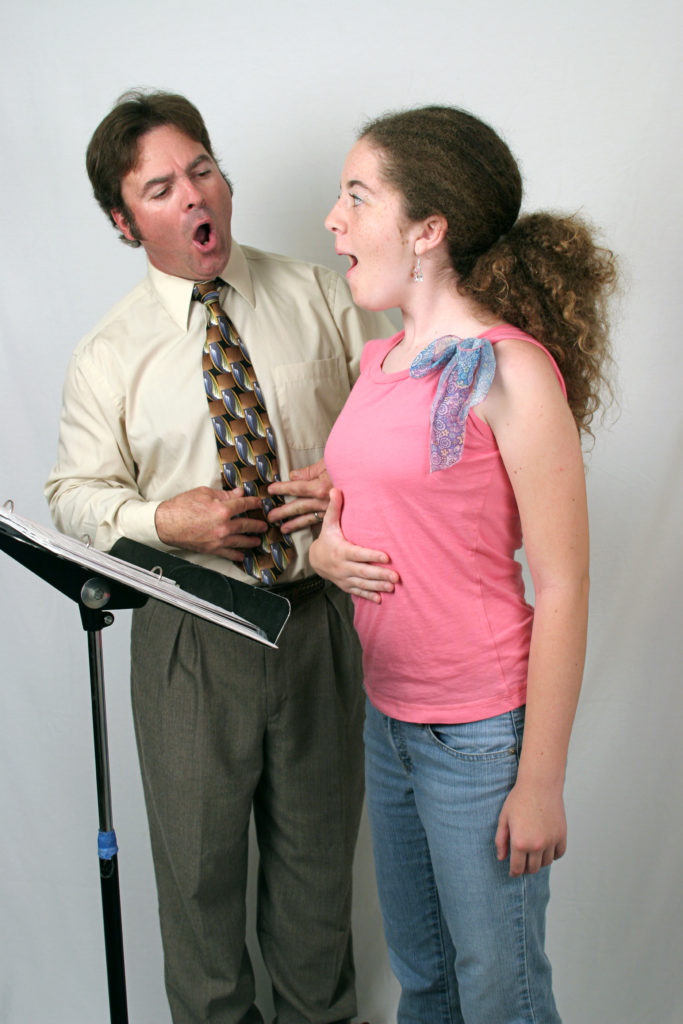 This weird direction is based on a number of useful vocal tools, but here’s why it doesn’t really mean anything. The diaphragm is a dome-like sheet of muscle that attaches to the bottom part of your thorax, or chest cavity, and is mostly an involuntary muscle. When you inhale, your diaphragm will contract and flatten, making room for air to rush into your lungs. When you exhale, your diaphragm will rise and dome again. Let me say that another way. No matter how you control your air, and no matter how you sing, your diaphragm will always (mostly unconsciously) be doing work.
This weird direction is based on a number of useful vocal tools, but here’s why it doesn’t really mean anything. The diaphragm is a dome-like sheet of muscle that attaches to the bottom part of your thorax, or chest cavity, and is mostly an involuntary muscle. When you inhale, your diaphragm will contract and flatten, making room for air to rush into your lungs. When you exhale, your diaphragm will rise and dome again. Let me say that another way. No matter how you control your air, and no matter how you sing, your diaphragm will always (mostly unconsciously) be doing work. This one tends to be propagated mainly by choir directors. There are more sopranos than altos if we’re categorizing singers according to the
This one tends to be propagated mainly by choir directors. There are more sopranos than altos if we’re categorizing singers according to the  But vocal injuries tend to be met with Internet comment sections full of sanctimonious musings on what things would look like “if only Adele had used healthy technique!” or “learned to use her diaphragm!” or (weirdly) “stopped using vocal fry!” Listening to the peanut gallery, you almost get a sense that a lot of people vindictively feel that the singer got what she deserved.
But vocal injuries tend to be met with Internet comment sections full of sanctimonious musings on what things would look like “if only Adele had used healthy technique!” or “learned to use her diaphragm!” or (weirdly) “stopped using vocal fry!” Listening to the peanut gallery, you almost get a sense that a lot of people vindictively feel that the singer got what she deserved.